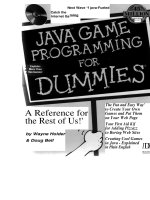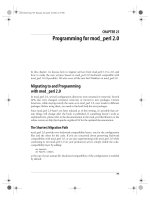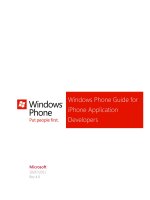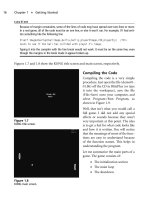SWIFT programming for IOS IOX
Bạn đang xem bản rút gọn của tài liệu. Xem và tải ngay bản đầy đủ của tài liệu tại đây (2.41 MB, 244 trang )
Swift
Swift
About the Tutorial
Swift is a new programming language developed by Apple Inc for iOS and OS X
development. Swift adopts the best of C and Objective-C, without the constraints of C
compatibility.
Swift uses the same runtime as the existing Obj-C system on Mac OS and iOS, which
enables Swift programs to run on many existing iOS 6 and OS X 10.8 platforms.
Audience
This tutorial is designed for software programmers who would like to learn the basics of
Swift programming language from scratch. This tutorial will give you enough
understanding on Swift programming language from where you can take yourself to higher
levels of expertise.
Prerequisites
Before proceeding with this tutorial, you should have a basic understanding of Computer
Programming terminologies and exposure to any programming language.
Execute Swift Online
For most of the examples given in this tutorial, you will find a Try it option, so just use
this option to execute your Swift programs on the spot and enjoy your learning.
Try the following example using Try it option available at the top right corner of the
following sample code box:
import Cocoa
/* My first program in Swift */
var myString = "Hello, World!"
println(myString)
Disclaimer & Copyright
Copyright 2015 by Tutorials Point (I) Pvt. Ltd.
All the content and graphics published in this e-book are the property of Tutorials Point (I) Pvt. Ltd.
The user of this e-book is prohibited to reuse, retain, copy, distribute or republish any contents or a
part of contents of this e-book in any manner without written consent of the publisher.
We strive to update the contents of our website and tutorials as timely and as precisely as possible,
however, the contents may contain inaccuracies or errors. Tutorials Point (I) Pvt. Ltd. provides no
guarantee regarding the accuracy, timeliness or completeness of our website or its contents
including this tutorial. If you discover any errors on our website or in this tutorial, please notify us
at
i
Swift
Table of Contents
About the Tutorial .................................................................................................................................. i
Audience ................................................................................................................................................ i
Prerequisites .......................................................................................................................................... i
Execute Swift Online............................................................................................................................... i
Disclaimer & Copyright ........................................................................................................................... i
Table of Contents .................................................................................................................................. ii
1.
SWIFT – OVERVIEW............................................................................................................ 1
2.
SWIFT – ENVIRONMENT..................................................................................................... 2
Try it Option Online ............................................................................................................................... 2
Local Environment Setup ....................................................................................................................... 2
3.
SWIFT – BASIC SYNTAX....................................................................................................... 6
Import in Swift ...................................................................................................................................... 6
Tokens in Swift ...................................................................................................................................... 6
Comments ............................................................................................................................................. 7
Semicolons ............................................................................................................................................ 7
Identifiers .............................................................................................................................................. 7
Keywords............................................................................................................................................... 8
Whitespaces .......................................................................................................................................... 9
Literals ................................................................................................................................................... 9
4.
SWIFT – DATA TYPES ........................................................................................................ 10
Built-in Data Types .............................................................................................................................. 10
Bound Values ...................................................................................................................................... 11
Type Aliases ......................................................................................................................................... 11
Type Safety .......................................................................................................................................... 12
ii
Swift
Type Inference ..................................................................................................................................... 12
5.
SWIFT – VARIABLES .......................................................................................................... 14
Variable Declaration ............................................................................................................................ 14
Type Annotations ................................................................................................................................ 15
Naming Variables ................................................................................................................................ 15
Printing Variables ................................................................................................................................ 16
6.
SWIFT – OPTIONALS ......................................................................................................... 17
Forced Unwrapping ............................................................................................................................. 17
Automatic Unwrapping ....................................................................................................................... 18
Optional Binding.................................................................................................................................. 19
7.
SWIFT – CONSTANTS........................................................................................................ 21
Constants Declaration ......................................................................................................................... 21
Type Annotations ................................................................................................................................ 21
Naming Constants ............................................................................................................................... 22
Printing Constants ............................................................................................................................... 22
8.
SWIFT – LITERALS ............................................................................................................. 24
Integer Literals .................................................................................................................................... 24
Floating-point Literals .......................................................................................................................... 24
String Literals....................................................................................................................................... 25
Boolean Literals ................................................................................................................................... 26
9.
SWIFT – OPERATORS ........................................................................................................ 27
Arithmetic Operators........................................................................................................................... 27
Comparison Operators ........................................................................................................................ 28
Logical Operators ................................................................................................................................ 28
Bitwise Operators ................................................................................................................................ 29
iii
Swift
Assignment Operators ......................................................................................................................... 30
Range Operators.................................................................................................................................. 31
Misc Operators .................................................................................................................................... 31
Operators Precedence ......................................................................................................................... 32
10.
SWIFT – DECISION MAKING ............................................................................................. 33
if Statement......................................................................................................................................... 34
if-else Statement ................................................................................................................................. 35
if...else if...else Statement ................................................................................................................... 36
Nested If Statements ........................................................................................................................... 38
Switch Statement ................................................................................................................................ 39
The ? : Operator .................................................................................................................................. 41
11.
SWIFT – LOOPS ................................................................................................................ 42
for-in Loop ........................................................................................................................................... 43
Swift – for Loop ................................................................................................................................... 44
Swift – while Loop ............................................................................................................................... 46
Swift – do-while Loop .......................................................................................................................... 47
Loop Control Statements ..................................................................................................................... 49
Swift – continue Statement ................................................................................................................. 49
Swift – break Statement ...................................................................................................................... 51
Swift – Fallthrough Statement ............................................................................................................. 53
12.
SWIFT – STRINGS ............................................................................................................. 56
Create a String ..................................................................................................................................... 56
Empty String ........................................................................................................................................ 56
String Constants .................................................................................................................................. 57
String Interpolation ............................................................................................................................. 58
String Concatenation ........................................................................................................................... 58
iv
Swift
String Length ....................................................................................................................................... 59
String Comparison ............................................................................................................................... 59
Unicode Strings ................................................................................................................................... 59
String Functions & Operators .............................................................................................................. 60
13.
SWIFT – CHARACTERS ...................................................................................................... 62
Empty Character Variables .................................................................................................................. 62
Accessing Characters from Strings ....................................................................................................... 63
Concatenating Strings with Characters ................................................................................................ 63
14.
SWIFT – ARRAYS............................................................................................................... 64
Creating Arrays .................................................................................................................................... 64
Accessing Arrays .................................................................................................................................. 64
Modifying Arrays ................................................................................................................................. 65
Iterating Over an Array ........................................................................................................................ 66
Adding Two Arrays .............................................................................................................................. 67
The count Property .............................................................................................................................. 68
The empty Property............................................................................................................................. 68
15.
SWIFT – DICTIONARIES..................................................................................................... 70
Creating Dictionary .............................................................................................................................. 70
Accessing Dictionaries ......................................................................................................................... 70
Modifying Dictionaries ........................................................................................................................ 71
Remove Key-Value Pairs ...................................................................................................................... 72
Iterating Over a Dictionary .................................................................................................................. 73
Convert to Arrays ................................................................................................................................ 74
The count Property .............................................................................................................................. 75
The empty Property............................................................................................................................. 76
16.
SWIFT – FUNCTIONS ........................................................................................................ 77
v
Swift
Function Definition .............................................................................................................................. 77
Calling a Function ................................................................................................................................ 78
Parameters and Return Values ............................................................................................................ 78
Functions without Parameters ............................................................................................................ 79
Functions with Return Values .............................................................................................................. 79
Functions without Return Values ........................................................................................................ 80
Functions with Optional Return Types ................................................................................................. 81
Functions Local Vs External Parameter Names .................................................................................... 81
External Parameter Names .................................................................................................................. 82
Variadic Parameters ............................................................................................................................ 82
Constant, Variable, and I/O Parameters .............................................................................................. 83
Function Types & its Usage .................................................................................................................. 84
Using Function Types ........................................................................................................................... 85
Function Types as Parameter Types & Return Types............................................................................ 85
Nested Functions ................................................................................................................................. 86
17.
SWIFT – CLOSURES........................................................................................................... 87
Expressions in Closures ........................................................................................................................ 88
Single Expression Implicit Returns ....................................................................................................... 89
Known Type Closures .......................................................................................................................... 90
Declaring Shorthand Argument Names as Closures ............................................................................. 90
Closures as Operator Functions ........................................................................................................... 91
Closures as Trailers .............................................................................................................................. 91
Capturing Values and Reference Types ................................................................................................ 92
18.
SWIFT – ENUMERATIONS ................................................................................................. 94
Enumeration Functionality .................................................................................................................. 94
Enumeration with Switch Statement ................................................................................................... 95
vi
Swift
Difference between Associated Values and Raw Values ...................................................................... 96
Enum with Associated Values .............................................................................................................. 96
Enum with Raw Values ........................................................................................................................ 97
19.
SWIFT – STRUCTURES ...................................................................................................... 99
Definition of a Structure ...................................................................................................................... 99
Accessing the Structure and its Properties ........................................................................................... 99
Best Usage Practices of Structures ..................................................................................................... 101
20.
SWIFT – CLASSES............................................................................................................ 103
Class Identity Operators .................................................................................................................... 105
21.
SWIFT – PROPERTIES...................................................................................................... 107
Stored Properties .............................................................................................................................. 107
Lazy Stored Property ......................................................................................................................... 109
Instance Variables ............................................................................................................................. 109
Computed Properties ........................................................................................................................ 109
Local and Global Variables ................................................................................................................. 112
Type Properties ................................................................................................................................. 112
Querying and Setting Properties ........................................................................................................ 113
22.
SWIFT – METHODS......................................................................................................... 115
Instance Methods .............................................................................................................................. 115
Local and External Parameter Names ................................................................................................ 116
External Parameter Name with # and _ Symbol................................................................................. 117
Self property in Methods ................................................................................................................... 118
Modifying Value Types from Instance Methods ................................................................................ 119
Self Property for Mutating Method ................................................................................................... 120
Type Methods ................................................................................................................................... 121
vii
Swift
23.
SWIFT – SUBSCRIPTS ...................................................................................................... 123
Subscript Declaration Syntax and its Usage ....................................................................................... 123
Options in Subscript .......................................................................................................................... 125
24.
SWIFT – INHERITANCE ................................................................................................... 127
Base Class .......................................................................................................................................... 127
Subclass ............................................................................................................................................. 128
Overriding ......................................................................................................................................... 129
Methods Overriding .......................................................................................................................... 129
Property Overriding ........................................................................................................................... 130
Overriding Property Observers .......................................................................................................... 131
Final Property to prevent Overriding ................................................................................................. 132
25.
SWIFT – INITIALIZATION ................................................................................................. 135
Initializer Role for Stored Properties.................................................................................................. 135
Setting Property Values by Default .................................................................................................... 136
Parameters Initialization ................................................................................................................... 136
Local & External Parameters .............................................................................................................. 137
Parameters without External Names ................................................................................................. 138
Optional Property Types .................................................................................................................... 139
Modifying Constant Properties During Initialization .......................................................................... 140
Default Initializers ............................................................................................................................. 141
Memberwise Initializers for Structure Types ..................................................................................... 142
Initializer Delegation for Value Types ................................................................................................ 142
Class Inheritance and Initialization .................................................................................................... 144
Initializer Inheritance and Overriding ................................................................................................ 146
Failable Initializer .............................................................................................................................. 148
Failable Initializers for Enumerations ................................................................................................ 149
viii
Swift
Failable Initializers for Classes ........................................................................................................... 150
Overriding a Failable Initializer .......................................................................................................... 150
The init! Failable Initializer ................................................................................................................ 152
Required Initializers ........................................................................................................................... 152
26.
SWIFT – DEINITIALIZATION............................................................................................. 154
Deinitialization to Deallocate Memory Space .................................................................................... 154
27.
SWIFT – ARC OVERVIEW ................................................................................................ 156
Functions of ARC ............................................................................................................................... 156
ARC Program ..................................................................................................................................... 156
ARC Strong Reference Cycles Class Instances ..................................................................................... 157
ARC Weak and Unowned References ................................................................................................ 158
Strong Reference Cycles for Closures ................................................................................................. 160
Weak and Unowned References ........................................................................................................ 161
28.
SWIFT – OPTIONAL CHAINING........................................................................................ 163
Optional Chaining as an Alternative to Forced Unwrapping .............................................................. 163
Defining Model Classes for Optional Chaining & Accessing Properties .............................................. 165
Calling Methods Through Optional Chaining ..................................................................................... 167
Accessing Subscripts through Optional Chaining ............................................................................... 169
Accessing Subscripts of Optional Type ............................................................................................... 172
Linking Multiple Levels of Chaining .................................................................................................... 175
Chaining on Methods with Optional Return Values ........................................................................... 178
29.
SWIFT – TYPE CASTING .................................................................................................. 181
Defining a Class Hierarchy ................................................................................................................. 181
Type Checking ................................................................................................................................... 182
Downcasting ...................................................................................................................................... 184
Typecasting:Any and Any Object ....................................................................................................... 186
ix
Swift
AnyObject.......................................................................................................................................... 189
30.
SWIFT – EXTENSIONS ..................................................................................................... 192
Computed Properties ........................................................................................................................ 192
Initializers .......................................................................................................................................... 193
Methods ............................................................................................................................................ 195
Mutating Instance Methods .............................................................................................................. 196
Subscripts .......................................................................................................................................... 196
Nested Types ..................................................................................................................................... 197
31.
SWIFT – PROTOCOLS...................................................................................................... 200
Property and Method Requirements ................................................................................................. 200
Mutating Method Requirements ....................................................................................................... 202
Initializer Requirements .................................................................................................................... 203
Class Implementations of Protocol Initializer Requirements .............................................................. 204
Protocols as Types ............................................................................................................................. 205
Adding Protocol Conformance with an Extension .............................................................................. 206
Protocol Inheritance .......................................................................................................................... 208
Class Only Protocols .......................................................................................................................... 210
Protocol Composition ........................................................................................................................ 211
Checking for Protocol Conformance .................................................................................................. 212
32.
SWIFT – GENERICS ......................................................................................................... 214
Generic Functions: Type Parameters ................................................................................................. 214
Extending a Generic Type .................................................................................................................. 216
Type Constraints ................................................................................................................................ 217
Associated Types ............................................................................................................................... 218
Where Clauses ................................................................................................................................... 220
33.
SWIFT – ACCESS CONTROL ............................................................................................. 223
x
Swift
Access Control for Function types ...................................................................................................... 223
Access Control for Enumeration types ............................................................................................... 224
Access Control for SubClasses ............................................................................................................ 225
Access Control for Constants, variables, properties and subscripts ................................................... 225
Getters and Setters............................................................................................................................ 226
Access Control for Initializers and Default Initializers ........................................................................ 226
Access Control for Protocols .............................................................................................................. 227
Access Control for Extensions ............................................................................................................ 228
Access Control for Generics ............................................................................................................... 229
Access Control for Type Aliases ......................................................................................................... 230
xi
1. Swift – Overview
Swift
Swift is a new programming language developed by Apple Inc for iOS and OS X
development. Swift adopts the best of C and Objective-C, without the constraints of C
compatibility.
Swift makes use of safe programming patterns.
Swift provides modern programming features.
Swift provides Objective-C like syntax.
Swift is a fantastic way to write iOS and OS X apps.
Swift provides seamless access to existing Cocoa frameworks.
Swift unifies the procedural and object-oriented portions of the language.
Swift does not need a separate library import to support functionalities like
input/output or string handling.
Swift uses the same runtime as the existing Obj-C system on Mac OS and iOS, which
enables Swift programs to run on many existing iOS 6 and OS X 10.8 platforms.
Swift comes with playground feature where Swift programmers can write their code and
execute it to see the results immediately.
The first public release of Swift was released in 2010. It took Chris Lattner almost 14
years to come up with the first official version, and later, it was supported by many other
contributors. Swift has been included in Xcode 6 beta.
Swift designers took ideas from various other popular languages such as Objective-C,
Rust, Haskell, Ruby, Python, C#, and CLU.
1
2. Swift – Environment
Swift
Try it Option Online
You really do not need to set up your own environment to start learning Swift
programming. Reason is very simple, we already have set up Swift environment online,
so that you can execute all the available examples online at the same time when you are
doing your theory work. This gives you the confidence in what you are reading and in
addition to that, you can verify the result with different options. Feel free to modify any
example and execute it online.
Try the following example using the Try it option available at the top right corner of the
following sample code box:
import Cocoa
/* My first program in Swift */
var myString = "Hello, World!"
println(myString)
For most of the examples given in this tutorial, you will find a Try it option, so just make
use of it and enjoy your learning.
Local Environment Setup
Swift provides a Playground platform for learning purpose and we are going to setup the
same. You need xCode software to start your Swift coding in Playground. Once you are
comfortable with the concepts of Swift, you can use xCode IDE for iSO/OS x application
development.
To start with, we consider you already have an account at Apple Developer website. Once
you are logged in, go to the following link:
Download for Apple Developers
2
Swift
This will list down a number of software available as follows:
Now select xCode and download it by clicking on the given link near to disc image. After
downloading the dmg file, you can install it by simply double-clicking on it and following
the given instructions. Finally, follow the given instructions and drop xCode icon into the
Application folder.
Now you have xCode installed on your machine. Next, open Xcode from the Application
folder and proceed after accepting the terms and conditions. If everything is fine, you will
get the following screen:
3
Swift
Select Get started with a playground option and enter a name for playground and
select iOS as platform. Finally, you will get the Playground window as follows:
Following is the code taken from the default Swift Playground Window.
import UIKit
var str = "Hello, playground"
If you create the same program for OS X program, then it will include import Cocoa and
the program will look like as follows:
import Cocoa
var str = "Hello, playground"
4
Swift
When the above program gets loaded, it should display the following result in Playground
result area (Right Hand Side).
Hello, playground
Congratulations, you have your Swift programming environment ready and you can
proceed with your learning vehicle "Tutorials Point".
5
3. Swift – Basic Syntax
Swift
We have already seen a piece of Swift program while setting up the environment. Let's
start once again with the following Hello, World! program created for OS X playground,
which includes import Cocoa as shown below:
import Cocoa
/* My first program in Swift */
var myString = "Hello, World!"
println(myString)
If you create the same program for iOS playground, then it will include import UIKit and
the program will look as follows:
import UIKit
var myString = "Hello, World!"
println(myString)
When we run the above program using an appropriate playground, we will get the following
result.
Hello, World!
Let us now see the basic structure of a Swift program, so that it will be easy for you to
understand the basic building blocks of the Swift programming language.
Import in Swift
You can use the import statement to import any Objective-C framework (or C library)
directly into your Swift program. For example, the above import cocoa statement makes
all Cocoa libraries, APIs, and runtimes that form the development layer for all of OS X,
available in Swift.
Cocoa is implemented in Objective-C, which is a superset of C, so it is easy to mix C and
even C++ into your Swift applications.
Tokens in Swift
A Swift program consists of various tokens and a token is either a keyword, an identifier,
a constant, a string literal, or a symbol. For example, the following Swift statement
consists of three tokens:
6
Swift
println("test!")
The individual tokens are:
println
(
"test!"
)
Comments
Comments are like helping texts in your Swift program. They are ignored by the compiler.
Multi-line comments start with /* and terminate with the characters */ as shown below:
/* My first program in Swift */
Multi-line comments can be nested in Swift. Following is a valid comment in Swift:
/* My first program in Swift is Hello, World!
/* Where as second program is Hello, Swift! */
Single-line comments are written using // at the beginning of the comment.
// My first program in Swift
Semicolons
Swift does not require you to type a semicolon (;) after each statement in your code,
though it’s optional; and if you use a semicolon, then the compiler does not complain
about it.
However, if you are using multiple statements in the same line, then it is required to use
a semicolon as a delimiter, otherwise the compiler will raise a syntax error. You can write
the above Hello, World! program as follows:
import Cocoa
/* My first program in Swift */
var myString = "Hello, World!"; println(myString)
Identifiers
A Swift identifier is a name used to identify a variable, function, or any other user-defined
item. An identifier starts with an alphabet A to Z or a to z or an underscore _ followed by
zero or more letters, underscores, and digits (0 to 9).
7
Swift
Swift does not allow special characters such as @, $, and % within identifiers. Swift is
a case sensitive programming language. Thus, Manpower and manpower are two
different identifiers in Swift. Here are some examples of acceptable identifiers:
Azad
zara
abc
move_name
a_123
myname50
_temp
j
a23b9
retVal
To use a reserved word as an identifier, you will need to put a backtick (`) before and
after it. For example, class is not a valid identifier, but `class` is valid.
Keywords
The following keywords are reserved in Swift. These reserved words may not be used as
constants or variables or any other identifier names, unless they're escaped with
backticks:
Keywords used in declarations
Class
deinit
Enum
extension
Func
import
Init
internal
Let
operator
private
protocol
public
static
struct
subscript
typealias
var
Keywords used in statements
break
case
continue
default
do
else
fallthrough
for
if
in
return
switch
where
while
Keywords used in expressions and types
as
dynamicType
false
is
nil
self
Self
super
true
_COLUMN_
_FILE_
_FUNCTION_
_LINE_
Keywords used in particular contexts
associativity
convenience
dynamic
didSet
8
Swift
final
get
infix
inout
lazy
left
mutating
none
nonmutating
optional
override
postfix
precedence
prefix
Protocol
required
right
set
Type
unowned
weak
willSet
Whitespaces
A line containing only whitespace, possibly with a comment, is known as a blank line, and
a Swift compiler totally ignores it.
Whitespace is the term used in Swift to describe blanks, tabs, newline characters, and
comments. Whitespaces separate one part of a statement from another and enable the
compiler to identify where one element in a statement, such as int, ends and the next
element begins. Therefore, in the following statement:
var age
there must be at least one whitespace character (usually a space) between var
and age for the compiler to be able to distinguish them. On the other hand, in the following
statement:
int fruit = apples + oranges
//get the total fruits
no whitespace characters are necessary between fruit and =, or between = and apples,
although you are free to include some for better readability.
Literals
A literal is the source code representation of a value of an integer, floating-point number,
or string type. The following are examples of literals:
92
// Integer literal
4.24159
// Floating-point literal
"Hello, World!"
// String literal
9
4. Swift – Data Types
Swift
While doing programming in any programming language, you need to use different types
of variables to store information. Variables are nothing but reserved memory locations to
store values. This means that when you create a variable, you reserve some space in
memory.
You may like to store information of various data types like string, character, wide
character, integer, floating point, Boolean, etc. Based on the data type of a variable, the
operating system allocates memory and decides what can be stored in the reserved
memory.
Built-in Data Types
Swift offers the programmer a rich assortment of built-in as well as user-defined data
types. The following types of basic data types are most frequently when declaring
variables:
Int or UInt – This is used for whole numbers. More specifically, you can use Int32,
Int64 to define 32 or 64 bit signed integer, whereas UInt32 or UInt64 to define 32
or 64 bit unsigned integer variables. For example, 42 and -23.
Float – This is used to represent a 32-bit floating-point number and numbers with
smaller decimal points. For example, 3.14159, 0.1, and -273.158.
Double – This is used to represent a 64-bit floating-point number and used when
floating-point values must be very large. For example, 3.14159, 0.1, and -273.158.
Bool – This represents a Boolean value which is either true or false.
String – This is an ordered collection of characters. For example, "Hello, World!"
Character – This is a single-character string literal. For example, "C"
Optional – This represents a variable that can hold either a value or no value.
We have listed here a few important points related to Integer types:
On a 32-bit platform, Int is the same size as Int32.
On a 64-bit platform, Int is the same size as Int64.
On a 32-bit platform, UInt is the same size as UInt32.
On a 64-bit platform, UInt is the same size as UInt64.
Int8, Int16, Int32, Int64 can be used to represent 8 Bit, 16 Bit, 32 Bit, and 64 Bit
forms of signed integer.
10
Swift
UInt8, UInt16, UInt32, and UInt64 can be used to represent 8 Bit, 16 Bit, 32 Bit
and 64 Bit forms of unsigned integer.
Bound Values
The following table shows the variable type, how much memory it takes to store the value
in memory, and what is the maximum and minimum value which can be stored in such
type of variables.
Type
Typical Bit Width
Typical Range
Int8
1byte
-127 to 127
UInt8
1byte
0 to 255
Int32
4bytes
-2147483648 to 2147483647
UInt32
4bytes
0 to 4294967295
Int64
8bytes
-9223372036854775808 to 9223372036854775807
UInt64
8bytes
0 to 18446744073709551615
Float
4bytes
1.2E-38 to 3.4E+38 (~6 digits)
Double
8bytes
2.3E-308 to 1.7E+308 (~15 digits)
Type Aliases
You can create a new name for an existing type using typealias. Here is the simple syntax
to define a new type using typealias:
typealias newname = type
For example, the following line instructs the compiler that Feet is another name for Int:
typealias Feet = Int
Now, the following declaration is perfectly legal and creates an integer variable called
distance:
import Cocoa
typealias Feet = Int
var distance: Feet = 100
println(distance)
When we run the above program using playground, we get the following result.
100
11
Swift
Type Safety
Swift is a type-safe language which means if a part of your code expects a String, you
can't pass it an Int by mistake.
As Swift is type-safe, it performs type-checks when compiling your code and flags any
mismatched types as errors.
import Cocoa
var varA = 42
varA = "This is hello"
println(varA)
When we compile the above program, it produces the following compile time error.
Playground execution failed: error: :6:6: error: cannot assign to 'let' value
'varA'
varA = "This is hello"
Type Inference
Type inference enables a compiler to deduce the type of a particular expression
automatically when it compiles your code, simply by examining the values you provide.
Swift uses type inference to work out the appropriate type as follows.
import Cocoa
// varA is inferred to be of type Int
var varA = 42
println(varA)
// varB is inferred to be of type Double
var varB = 3.14159
println(varB)
// varC is also inferred to be of type Double
var varC = 3 + 0.14159
println(varC)
12
Swift
When we run the above program using playground, we get the following result:
42
3.14159
3.14159
13









